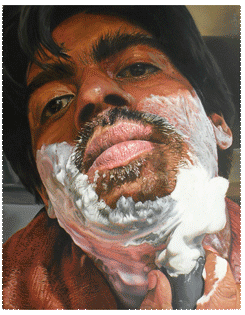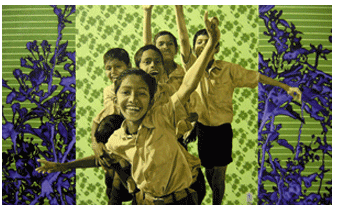- Prelude
- Guest Editor’s Column
- Hard Talk
- Eloquence of Silence
- The Age of Revivals: Gothic Revival Furniture
- Inkwell
- New Media : Living up to the chivalric code
- Universalizing Art through Individual Langue
- Speaking New Discourses
- Video Art of India- Gigi Scaria and his Videos
- Contemporary Trends of Sculpting
- In the News
- Artist Index and Statistics
- Market Insight
- Auction Reports
- The month that was
- Art Bengaluru
- Mumbai Artsighting
- Musings from Chennai
- Deccan Odyssey
- Delhi Dias
- In between – from Vadodara
- North-East Opsis
- A Tryst with Art in Madhya Pradesh
- Tradition and Beyond
- Reverie
- Indian (Sub) Way
- Creative Impulse
- Different hues of Aakriti
ART news & views
Speaking New Discourses
Volume: 2 Issue No: 8 Month: 9 Year: 2010
|
A photograph can pull a fast one just as easily as document the truth. A just-bereaved person can be snapped in neutral moment if the cameraperson decides to highlight an inconsequential nanosecond between immersive griefs. An editor can choose to print a photo of a grinning President in the wake of a national calamity. What they are doing is using or abusing their freedom to manipulate, and by doing so, projecting a vision or whimsy that is personal, perhaps motivated. An artist of course has to go beyond mere manipulation of moments, or tinkering with the infinite tools that technology affords, in fact, has to overcome all the cheap tricks, to convincingly pitch a private response to a reality. It becomes even more difficult when the reality itself is a simulated digital reality, a blown-up, graphed, morphed and photoshopped reality.
Shoma Bhattacharya |
| Vivek Sharma Observation is the key tool for a visual artist. Examining physical attributes of his subjects or studying the events in the surroundings, an artist must grasp the essence of what he wants to portray. Mumbai-based Vivek Sharma has a sharp set of eyes which he trains on people as much to portray them photo-realistically as to capture the human condition.
Jasmin Shah Varma |
| Saptarishi Naskar Saptarishi Naskar received his education in fine arts at Shantiniketan and is presently based in Delhi. He entered the art scene in Delhi in 2005 and quickly got recognition for his firm grounding in visual grammar and the high level of engagement with contemporary socio-politics. Since then, Naskar's art has managed to constantly touch a chord. His subjects mostly deal with the problems faced by the 'common man'. Looking at same old laments with a new perspective, Naskar manages to find the elements of positivity in situations where none seem to exist.
Ravisha Mall |
 where the sun-kissed metallic handle of prescription glasses and the strong planes of cheekbones assume an alluring solidity. For a second, the high level of technical virtuosity, his dazzling felicity with both brush and pencil, dismissed as plebian toil in exospheres of modernity, or slandered as giant photo copies in meaner clusters, threatens to draw an opaque curtain on everything else. The touchy-feely cups and teabags, the thick-ash cigarette tip blow away and boggle. On occasions, sharp contrasts, and on others, subtle lighting and shading effects fill the landscape of face and coffee table with possibilities.
where the sun-kissed metallic handle of prescription glasses and the strong planes of cheekbones assume an alluring solidity. For a second, the high level of technical virtuosity, his dazzling felicity with both brush and pencil, dismissed as plebian toil in exospheres of modernity, or slandered as giant photo copies in meaner clusters, threatens to draw an opaque curtain on everything else. The touchy-feely cups and teabags, the thick-ash cigarette tip blow away and boggle. On occasions, sharp contrasts, and on others, subtle lighting and shading effects fill the landscape of face and coffee table with possibilities. Or he could be portraying an office-going woman in shiny stilettos in Germany (Kaliyug). In one work he portrays Mahatma Gandhi and in another there's President Barack Obama upside down on a chess board carried by the deity Hanuman. “I look at everyday experiences and news to convey messages whether personal, social or political,” he explains. He also uses references from myths, historical events and well-known works of art by artists in his scheme.
Or he could be portraying an office-going woman in shiny stilettos in Germany (Kaliyug). In one work he portrays Mahatma Gandhi and in another there's President Barack Obama upside down on a chess board carried by the deity Hanuman. “I look at everyday experiences and news to convey messages whether personal, social or political,” he explains. He also uses references from myths, historical events and well-known works of art by artists in his scheme.  Since his works deal with human nature, and the lived experience of the 'public', it has to be realistic and relatable to the people who are his inspiration. He employs mediatic realism to recreates what he observes, and often adds a twist to guide his viewers towards his intentionality. In the artist's own words “Here is another extension of my organic-inorganic fusion concept. I happen to believe that we can go from photorealism to real abstraction feelings. When art work is related to human nature, the primary language is realism. It comes very close to society.”
Since his works deal with human nature, and the lived experience of the 'public', it has to be realistic and relatable to the people who are his inspiration. He employs mediatic realism to recreates what he observes, and often adds a twist to guide his viewers towards his intentionality. In the artist's own words “Here is another extension of my organic-inorganic fusion concept. I happen to believe that we can go from photorealism to real abstraction feelings. When art work is related to human nature, the primary language is realism. It comes very close to society.”